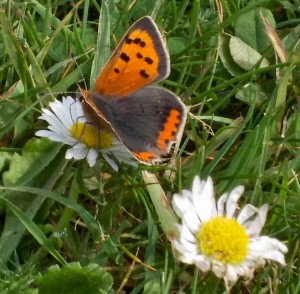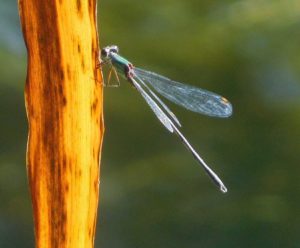
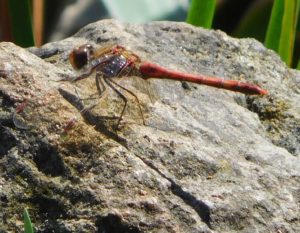
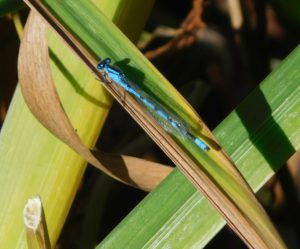
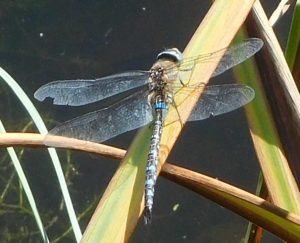

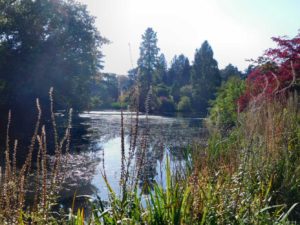
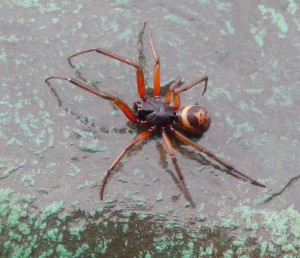
Well, it was certainly a large and striking spider with a distinctive crescent mark on the forward slope of its abdomen, so “False Widow Spider?” sprang into my mind. It was, amusingly, making itself conspicuous on the noble bronze surface of the Henry Moore statue in Kew Gardens: there’s just one now, reminding old-timers of the ‘one behind every bush’ feeling we had in 2006 when the gardens were full of Henry Moores, and I confess I pretty much ‘understood’ what they were about for the first time, seeing them against a natural (well, you know what I mean) background as massive, handsomely curved figures. One was near a splendidly branchy conifer, its huge curved branches setting off the sculpture.
But I digress. The spider had a finely moulded cephalothorax and a large, nearly globular abdomen, marked with a sandy crescent and a dotted area. Its legs were distinctively reddish. Back at home, I looked up images of false widows. It certainly wasn’t the large native False Widow, Steatoda bipunctata. It looked much like the introduced Steatoda nobilis; perhaps the dotted area on the abdomen was not typical, but it seems close enough. The species, according to the Natural History Museum, arrived here in the 1870s — not quite such a new arrival as the ebola-panicky tabloid newspapers seem to think, then. It most likely arrived among bananas from Madeira and the Canary Islands, so it really is a subtropical scary. It can “live comfortably in our homes all year round”, says the museum cheerily, and is now common and widespread. And yes, it does bite; but the effect is not much worse than a wasp sting. I suspect a bit of hydrocortisone cream would sort it out nicely. Or a swift tap with a shoe, of course.
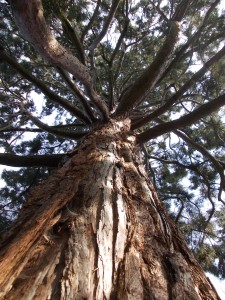
One of the unceasing delights of nature is the feeling, some days more clearly justified than on others, of coming into contact with Darwin’s ‘endless forms most beautiful‘. A marvellous botanic garden – it has to be a large one, like Kew – takes one perhaps more directly into that space of wonder and delight than anything else, if it is laid out taxonomically to show the variation and diversity within one group after another.
Today we wandered happily among the Conifer section of Kew Gardens, gazing straight up into the patches of sky between the radiating branches of the Giant Sequoia, feeling the soft fibrous red bark and wondering why everything is larger in America.
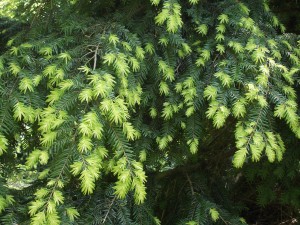
Then on to the Hemlocks and Spruces, delighting in the pattern of bright new bunches of needles scattered in diverse patterns among the older, darker growth: of course the new leaves are always at growing tips, so the patterns reveal the habit of growth of each species.
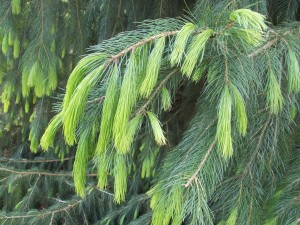
Many of the spruces are adorned with new male cones; those of Picea orientalis ‘aurea’ are a surprisingly pretty pink.
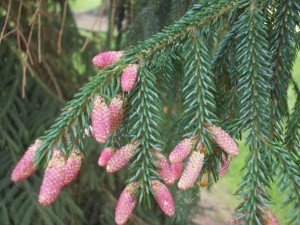
The male cones of the Bishop’s Pine, Pinus muricata, from California are, on the other hand, grouped into pineapple-like spirals and surrounded by the Pine genus’s characteristic pairs of long slender needles, forming a fine rosette.
Down at the end of the gardens, Queen Charlotte’s cottage ornée (just for picnics, never inhabited; the royal party could walk down the mile and a half from the red-brick Kew Palace, or came (often) by carriage to play a la Marie Antoinette at having a little cottage in the woods. The 37 acres of bluebell woods around the cottage form a nature reserve, complete with real badgers, inside the gardens. As well as the Bluebells, Alkanet and Ramsons made the woodland floor lovely, while around the margins skipped Orange Tips, Brimstones, Peacock butterflies and Small Coppers. Fit for a Queen.
